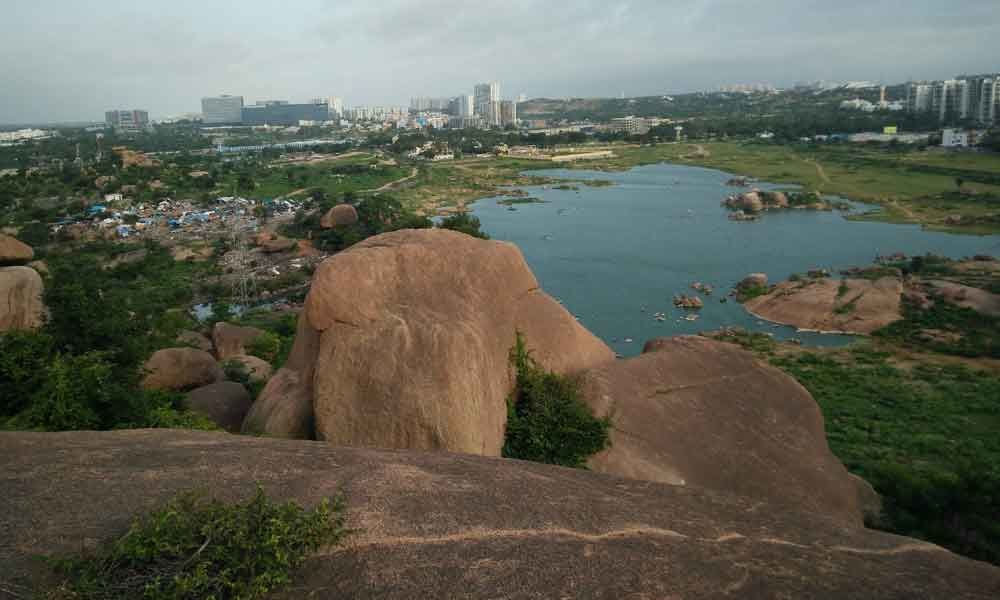Famed Fakhruddin Gutta facing grave threat

Hyderabad’s unique rock formations dating back to 2,500 million years may well vanish in the next few days if the ongoing drilling of boulders is allowed.
Khajaguda: Hyderabad's unique rock formations dating back to 2,500 million years may well vanish in the next few days if the ongoing drilling of boulders is allowed. In spite of a High Court directive to ensure that the rocks are not destroyed during the pendency of the writ petition. A petition was filed on April 29 construction workers were seen drilling holes on the boulders.
• Unique rock formations being destroyed, may be lost to future gen
• Rocks of the Deccan plateau are amongst the oldest in the world
• An ideal location for outdoor activities like rock climbing
• Heritage conservation committee of HMDA accused of indifference
The Fakhruddin Gutta at Khajaguda is a favourite spot for rock climbers and for picnics. The Society to Save Rocks too conducts its annual meet at the hill. Sangeeta Varma, the treasurer of Society to Save Rocks, says "The rock formations were under the protected list but were not included in the schedule attached to the Telangana Heritage (Protection, Preservation, Conservation and Maintenance) Act, 2017."
It may be noted that in 2011, the then government had plans to construct houses for bureaucrats, but the project was shelved after protests. Ever since, there have been attempts to clean up the area for construction activity.
There is an 800-year-old Anantha Padmanabha Swamy shrine atop the hill along with an ancient dargah, Baba Fakhruddin Aulia's tomb. A number of devotees visit them from across the city.
Nature & adventure park on back burner
The Government of Telangana had plans of developing the area as a nature and adventure park and also conducted a series of meetings. Senior officials in the know of things said on condition of anonymity that the land rates in Khajaguda, Gachibowli and surrounding areas have risen multiple times and it could be one of the reasons for the idea not getting a green signal.
Meghna Pant, a software professional and resident of Gachibolwi, says, "I was bowled over by the rock formations and the view from up the hill is lovely. If the hill could be saved and made into an adventure park we could save it for posterity."
The Fakhruddin Gutta is an ideal location for outdoor activities and the undulating terrain just right for rock climbing and spending a quiet evening.
A part of the hillock falls under private property, but the rock precinct is under HMDA. Raghu, a heritage enthusiast said, "The heritage conservation committee in HMDA has become defunct and there is no one to raise a voice against destruction. In spite of several petitions and requests to set up sign boards there is no response." Sangeeta says, "We also requested the authorities that we would spend money and place boards but there has been no response."
The drilling of boulders is going on and the matter would be heard on June 6. Will the boulders that survived for centuries still be there by then is a question that heritage lovers are asking?
CLARION CALL TO SAVE ROCKS
The clamour to save the rocks is gaining momentum on social media. Citizens have been signing a petition in large numbers. A member of the society says, "Thousands are signing the petition and people not just in and around Khajaguda but also from other parts of the city are keen on saving the hill.
Why save Fakhruddin Gutta
A few people are breaking down rock formations at Baba Fakhruddin Aulia Dargha at Puppalguda in Survey Nos 452/1, 448, 450/1 and 450/2. The court gave a directive to ensure that the rocks should not be disturbed or damaged or destroyed during the pendency of the writ petition.
Rocks of the Deccan plateau are amongst the oldest in the world. Geologists date these rocks 2,500 million years back. That is the time when the earth's crust solidified. Molten magma then pushed upwards from the interior and hardened under the crust into domes and sheets of granite. Horizontal and vertical cracks developed.
When, slowly, the top layers of the crust eroded, and these very hard granites were exposed, they weathered over millions of years into their present forms. This happened along their horizontal and vertical cracks during - what is called - onion peel weathering (or spheroidal weathering), rounding the stones - and the bizarre formations resulted.

















